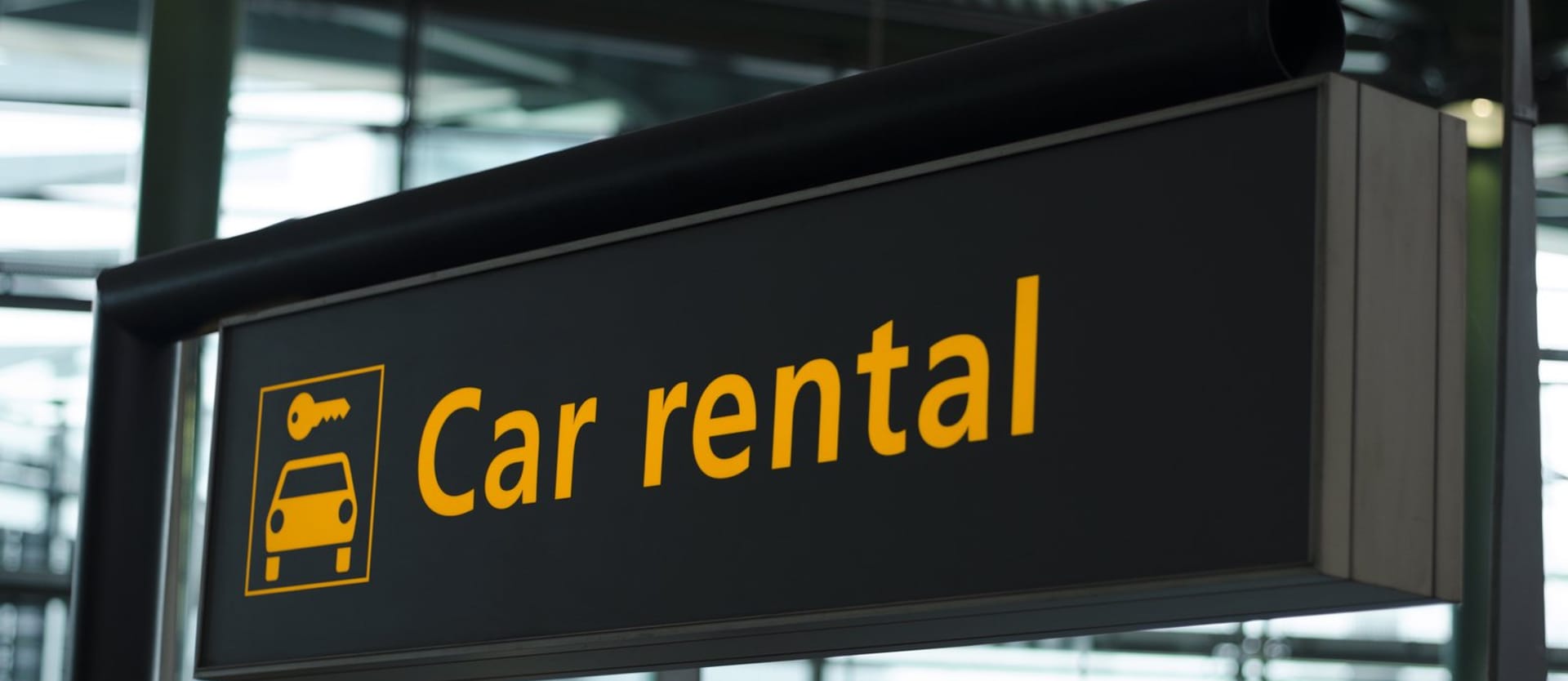Many travelers take renting a car for granted especially during the pandemic when isolation is a priority. Customers prefer convenient and timely service, but it's not uncommon for car rentals to lag. Roughly speaking, vehicle pick-ups delay every third time. Considering the tight competition in this business landscape, car rental services can’t fail to satisfy their customers.
If you want to accept online reservations and manage your fleet with ease, what you need is a Car Rental Reservation System (RRS). In this article, we’ll tell you about the underlying modules of a Car RRS, review some of the key software providers, and give tips for those ready to roll up their sleeves and build their own platform.
Car Rental Reservation System modules
If a driver decides to rent a car beforehand, they go to a car rental website or app and find a vehicle that meets their needs. Then, they book it and pay for the chosen rental period, if upfront payment is required.
On the appointed day, this customer arrives at the car rental location to pick up the chosen car. An agent makes copies of their IDs, explains the terms of the lease, instructs them on any special features of the car, and finally hands them the keys. When the customer drops off the car, the agent checks its mileage and inspects for any damages.
In fact, the car rental process involves many more operations under the hood. Automating them improves the speed and quality of service. Let’s zoom in on how each module of the Car RRS contributes to that.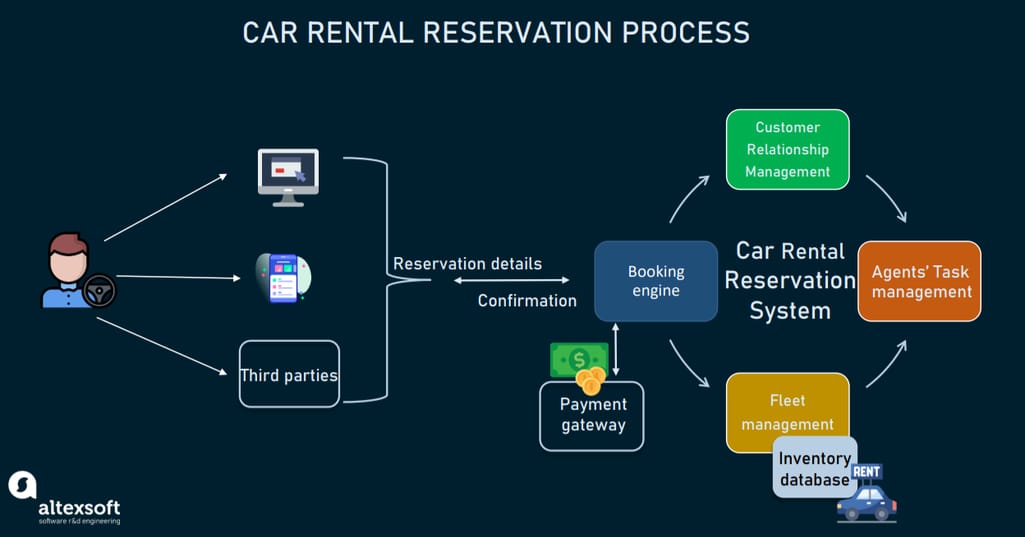
Car rental process using a Car Rental Reservation System
Car rental booking engine
A booking engine is at the forefront of the car rental reservation system. Synced up with the inventory database, the engine obtains the updated list of available cars for the dates, accessories that come with them, and their quotes. Additionally, the module typically performs the following functions.
Payment operations. Connected with a payment gateway (such as PayPal, Braintree, and Stripe,) the booking engine accepts online payments from customers and issues electronic invoices. It also tracks pending customer payments and calculates all rental costs, providing financial reports.
Reservation processing. To complete the booking, the engine
- delivers reservation details to the fleet management module,
- enters customer details in the Customer Relationship Management module,
- notifies the Task Management module so that agents can prepare the car on time, and
- sends the customer a confirmation of their reservation.
Handling distribution channels. Also, reservations can come from third parties. GDSs, OTAs, and other travel consolidators integrate with the booking engine to access its car rental itinerary and distribute it on their side. A booking engine calculates and assigns them their referral rates.
As for the walk-in and telephone bookings, a car rental agent manually inputs them into the system.
Fleet management
A fleet requires lots of tracking: from locating and distributing vehicles to customers to monitoring car health, including the history of damage and repairs. We have a comprehensive article on fleet management.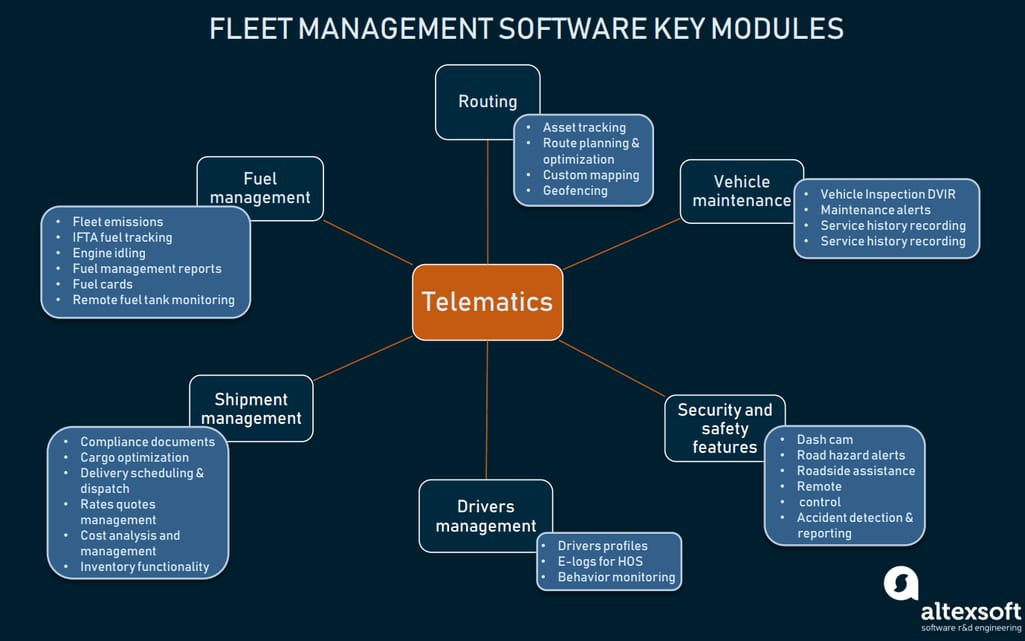
A full picture of the key features of the Fleet Management Software
Although more centered around the needs of shipping companies, some modules and functions described there are more or less relevant to car rental companies, particularly, asset tracking, fuel management, and vehicle maintenance. Now, let’s talk about these and other fleet management features from the car rental point of view.
Telematics and remote monitoring. The rental inventory of a car rental facility is less predictable than other travel-related resources, such as airlines or hotels. So, it needs close monitoring which can be accomplished via telematics.
Installed in a car, a device collects and transmits vehicle info such as location, mileage, fuel consumption, speed, and temperatures, using GPS and onboard diagnostics. With telematics integrated into the car rental software, you can both track your cars online or run a playback to check the routing details afterward.
Car history. Updating the car history, we keep track of all the maintenance tasks it has undergone. Also, it helps secure the condition of the car before delivering it to the customer so that you can easily perform the before-and-after inspection. Generating asset condition reports with pictures and videos, the system minimizes damage disputes that can occur.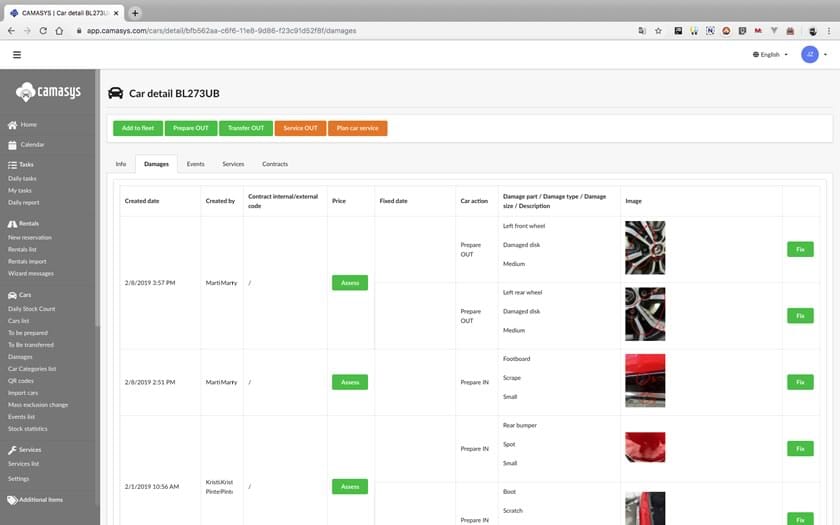
Electronic car records show what damage has occurred and when. Source: Camasys
Rental car distribution. The system can measure vehicle usage and distribute the load equally throughout the fleet and avoid putting rundown assets on the road. In case of any car problems, it automatically assigns another available vehicle for the approved reservation. At the same time, monitoring the workload of each asset in the fleet, the system may set a reservation limit if the number of bookings is about to exceed the number of idling cars.
Graphic aids. The fleet chart helps with car distribution. It provides the full picture of the current car occupancy and allows for assessing the availability of vehicles for the coming days and optimizing the fleet accordingly. Besides the fleet itself, the system can graphically present the availability of other equipment such as GPS, child seats, etc.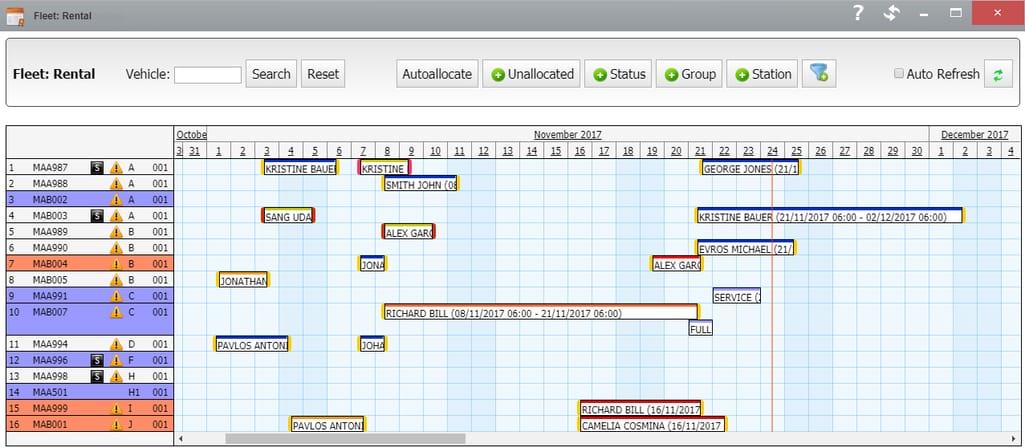
Fleet chart. Source: Carhire
Overbooking. When it comes to overbooking, there are two ways of thinking. Similar to airlines and hotels, some rental car companies overbook to compensate for no-shows and to offset drivers who return cars early. Others prefer to avoid overbookings because they don’t want to end up in a situation where they can’t provide a car for a reservation. And that all depends on how accurately you estimate future reservation requests. As a backup, you can assign a vehicle of a different group if the booked one is already occupied. The system will quickly make adjustments between locations, reservations, and contracts.
Reports generation. Always gathering statistics, the system generates up-to-date ad hoc reports. Measuring the revenue from rentals against expenses, it can calculate the profit of the entire fleet, as well as its specific category. By checking the number of cars occupied on a day and their locations, you can develop statistics for future use.
Car rental agents’ task management
While managing the assets, car rental agents need to streamline their work behind the counter. Car RRS brings tangible improvements to how agents perform their duties. At some point, you can put your business on autopilot and the task management module will automatically assign roles to each task at hand.
Scheduling. Car rental agents manage their errands in the software dashboards so they are well-informed on what’s on their to-do list today and which tasks have more priority. They can also set time for each task, such as serving a customer, inspecting a vehicle, completing paperwork, taking payments, etc.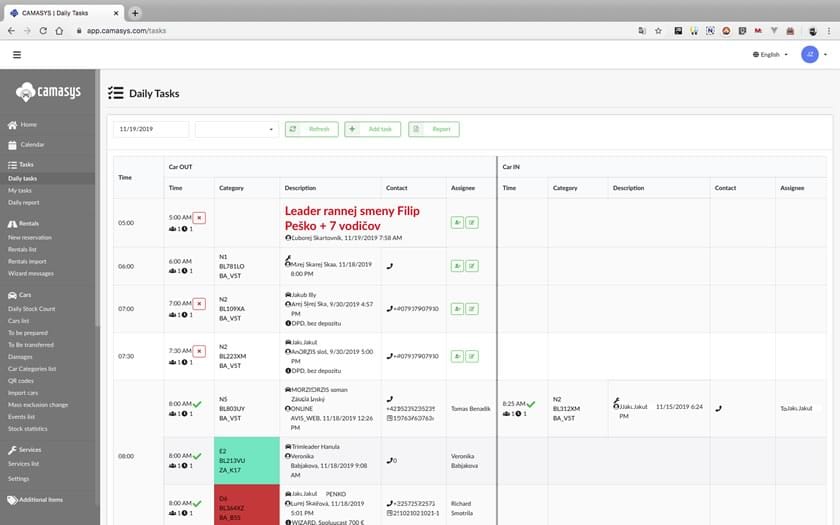
A dashboard for managing day-to-day tasks. Source: Camasys
Planned vehicle return. Agents can check the cars due to arrive soon and start the necessary preparations beforehand.
Automatic reminders. The system gives automatic reminders for a number of tasks like car service, oil change, annual vehicle tests such as the Ministry of Transport (MOT) test in the UK, etc.
Autofill. Scanning a driver's license, the system can automatically fill in the client details in a customer form.
Customer Relationship Management
Within the car rental system, CRM stores customer history and statistics and sends them notifications. The system can assist in conducting satisfaction campaigns by sending out evaluation forms to clients. Upon receiving a complaint from a customer, the system will automatically follow up.
Notifications. CRM keeps customers updated on the booking status, informing them of any important details related to their reservation (e. g. required documents and copies, fees, and receipts.) Each programmed email is triggered by a certain action performed by the software at a certain time during the car rental process. For example, a customer receives a booking confirmation right after the software has processed the booking, while a reminder is sent a few days prior to the upcoming booking dates.
Satisfaction measurement. From the moment a user searches for car prices to the moment they return the car, there may be bottlenecks that impede business progress. Why are potential customers churning before making a booking? Why do you keep getting negative reviews? Why can’t you retain customers? Answering these and many other similar questions will help you detect problems and work towards their solution. The software can formulate customer questionnaires for a complete analysis.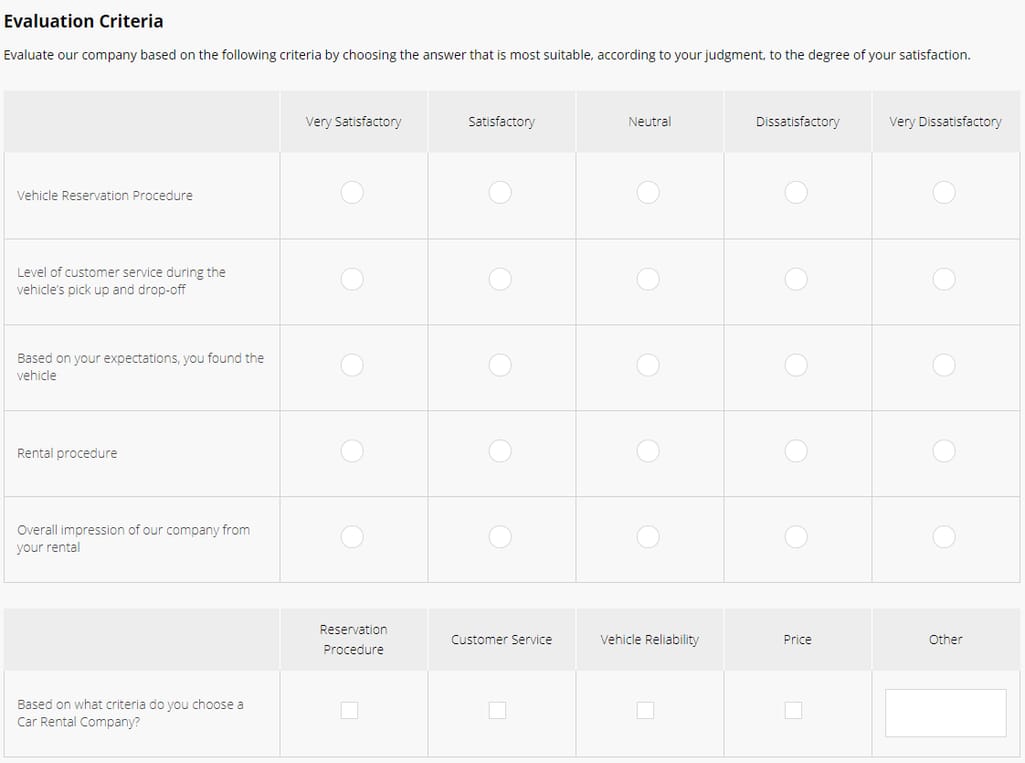
Customer satisfaction survey at Hertz
Car rental reservation solutions for the existing systems
All this time we’ve been addressing car rental companies that operate their own fleet. But what do you do if you want to manage bookings of vehicles that aren’t part of your direct inventory? Below, we’ll discuss integration options and a subsidiaries management module that addresses the needs of businesses managing multiple car rental brands.
Integration with suppliers
Customers can check available vehicles and book online directly from an OTA, a tour operator, or a car rental marketplace when those are connected to the suppliers’ booking engines. So, if you already run a travel business and want to expand it with car rental services, you have several options for doing it.
APIs. You can integrate car rental inventory via Application Programming Interfaces. In another article, we discussed the leading car rental APIs. Have a look at it for our picks of suppliers to integrate with.
Booking engine. Instead of integrating APIs one by one, you can adopt a booking engine with pre-integrated suppliers. At AltexSoft, we have built an all-in-one platform with car rentals, flights, and hotels. It’s a customizable set of integration modules along with mapping tools
Iframe. You can also load the supplier’s booking engine in an Iframe by inserting their block of code in your existing website. Using deep-links, you can function as a car rental search engine without booking capabilities.
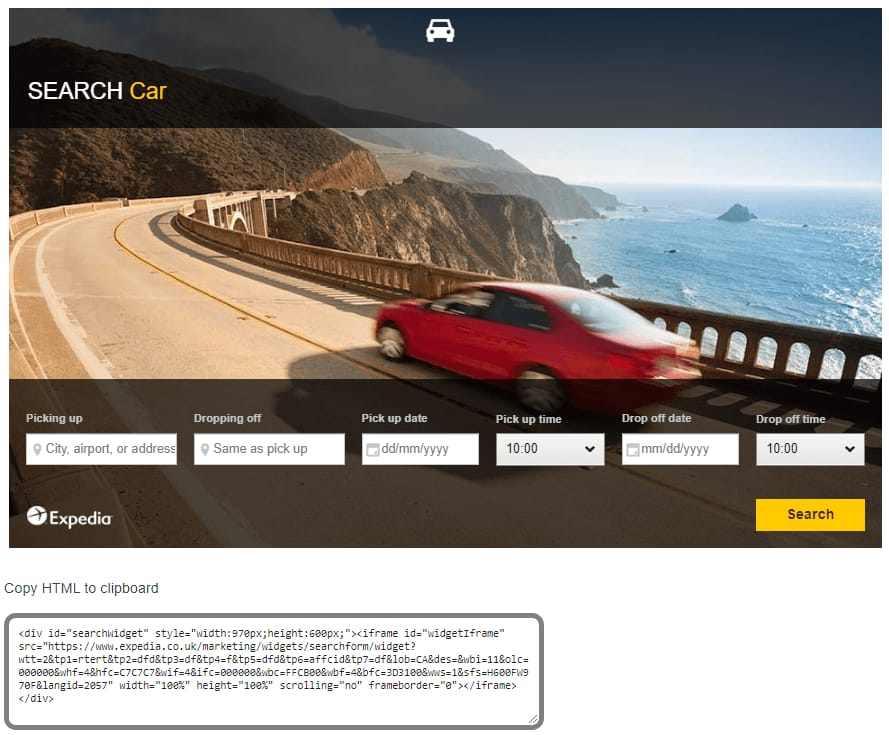
Expedia’s car rental Iframe with a block of code for integration
Subsidiaries management
Car rental companies that manage multiple local car rental brands need to ensure collaboration tools and tools for convenient reporting. That’s how they can trace car availability and rental activity at their locations while getting sales reports.
A good tool for tracking your subsidiaries’ performance is an Agent Portal. Smaller agents can log in to the portal and submit their bookings directly into the system. Synced up with the portal, the Car Rental Reservation System can further process the obtained data - set custom efficiency indicators for each subsidiary and invoice them accordingly.
Car Rental Reservation Software Providers
Selecting the software for your car rental business, be ready to conduct a comprehensive research. First, decide on the following:
- fleet size,
- the technical skill of your staff and the level of complexity they can deal with,
- key features and integrations you need, and
- your budget limits.
After you’ve picked an initial list of providers, study reviews of their customers, and test the solutions yourself if they provide demo versions or a free trial.
There are quite a lot of Car CRSs out in the market today, making shopping for one a bit difficult at times. Let this list of four recognized solutions be your starting point in choosing your Car CRS.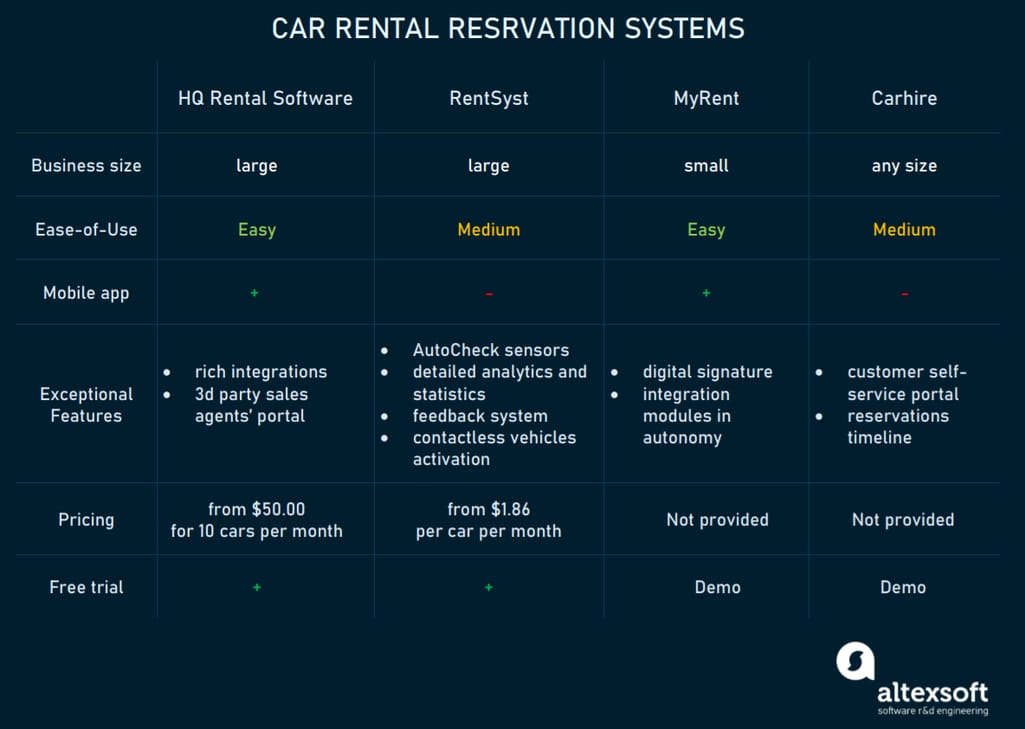
Four leading Car Rental Reservation Systems compared
HQ Rental Software
Users praise cloud-based HQ Rental for its customization capabilities and claim that it can be fully adapted to your needs within a week. To enable online reservations, you simply install their plugin on your website. Integrated with over 15 payment gateways, the plugin will support full and down-payments directly online.
Besides that, HQ Rental is pre-integrated with marketplaces that distribute their services as well as with insurance companies, self-service rentals, yield management tools, and many more solutions. HQ Rental has an open API that lets developers create custom connections with third-party solutions.
Five steps of the booking process with HQ Rental
Agents can manage their daily job from a single HQ Rental app.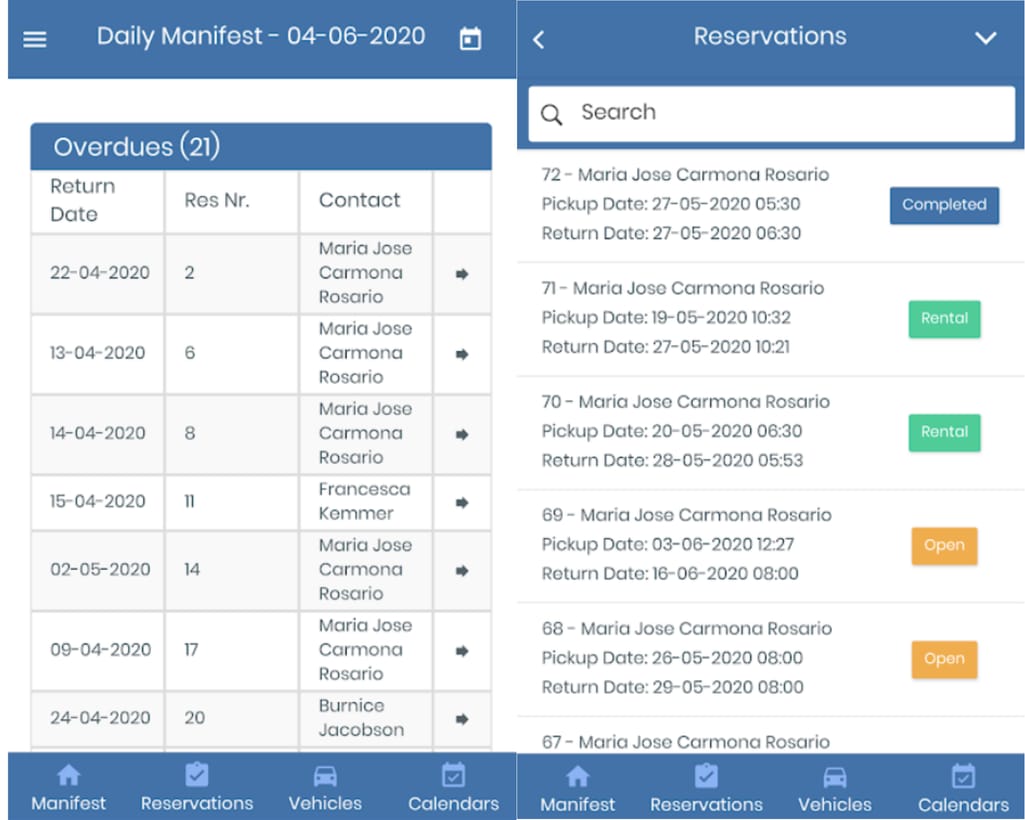
Reservation management with the HQ Rental app
HQ Rental allows you to manage your
- vehicles,
- rates and invoices,
- add-ons,
- maintenance,
- customer relationship tools, and
- a third-party sales agents portal.
Users claim that HQ Rental lacks niche features like provisional bookings handling. They also point out the software’s poor parking and fines management and unsatisfactory check-in / check-out procedures. However, any HQ’s functionality problems are compensated with the customer service that is always there to help.
RentSyst
RentSyst’s forte in found in the following features:
- control of each asset with the built-in AutoCheck sensors: from the amount of fuel consumed to indications of aggressive driving behavior and speeding;
- document templates for generating contracts and invoices;
- a feedback system for clients to give reviews and rate the service;
- contactless vehicle activation from a customer’s personal account;
- detailed analytics and statistics, i.e., the software generates a profitability analysis, provides secure bookkeeping and gives accurate forecasts to optimize daily operations.
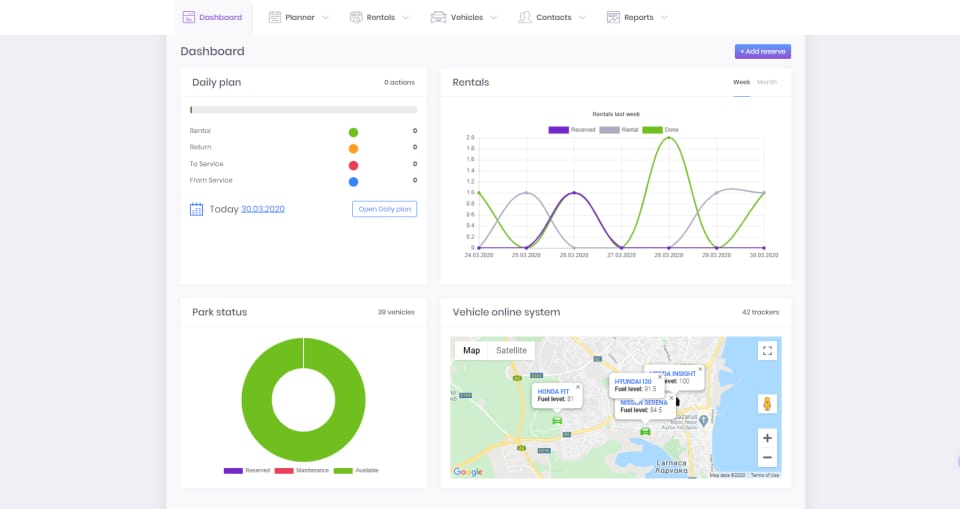
RentSyst’s statistics dashboard
In contrast with HQ Rental, RentSyst has no fines management at all.
The software is integrated with payment (MasterCard, Visa, PayPal) and mailing (Viber, WhatsApp, and Telegram) services.
MyRent by Dogma Systems
Because of being in the vehicle rental industry for over 12 years, Dogma Systems developed MyRent. The system allows for integrating its fleet management and tariff configurations separately.
The brightest features of MyRent are
- vehicle check-out /check-in management,
- digital signature from the tablet for fast and simple rental contracts, and
- integration opportunities via the API that also allows for defining price strategy with third parties.
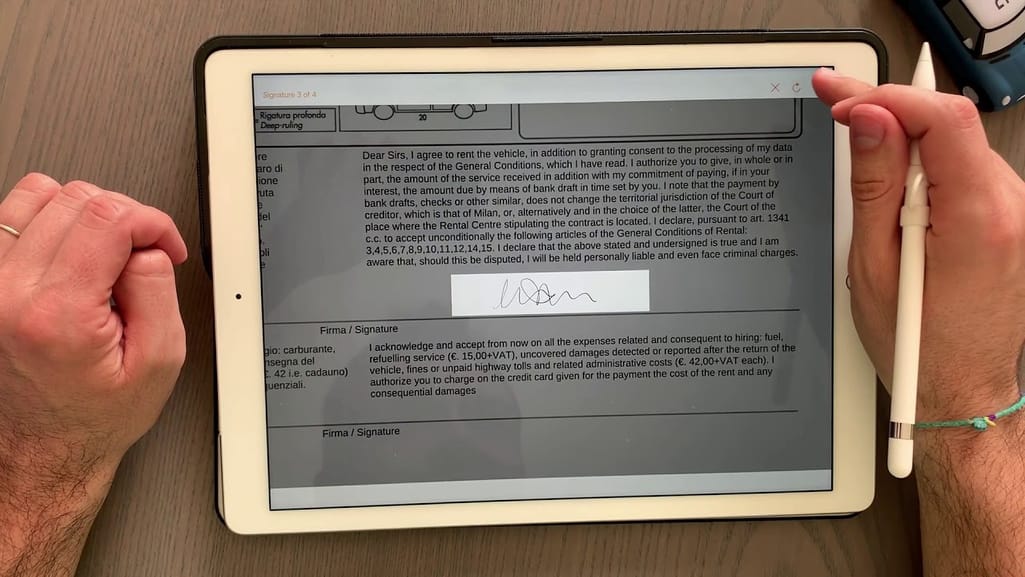

Digital signature process with MyRent
Customers highlight their quick and easy bulk updates of price and availability. At the same time, they say that reporting features could be improved as “in some cases, to get full information, you have to jump from one slide to another.”
Carhire Manager Web by Datalogic
Cloud-ready car rental management software, Carhire can be installed on-premises as well. It’s a comprehensive solution that provides fixes at all levels: front office, backend, and customer-facing functionalities. Also, Carhire connects the car rental business with its partners via an API to access their rates and promotions. So, you can expand the reach beyond your existing customers.
The Carhire outstanding features are:
- a Customer Self-Service Portal to view vehicle availability in real-time,
- the Reservations Timeline to track the status of the vehicle due for maintenance, for delivery or pick-up, or currently on the road, and
- the estimation of the influx of bookings to prepare for future demands.
Datalogic provides good customer service with implementing the software.
Carhire offers three pricing models. Its Full License provides access to all features and requires a one-time payment. Software Rental is available for monthly payments. And there’s also Cloud-Ready option with a virtual server.
When to develop a custom solution
If you are a car rental company with unique requirements that the market can’t satisfy, you may think of developing a custom car reservation system with the functionality necessary to run your business the way you see it.
Assessing the feasibility of this decision, calculate the estimated costs and effort for building a Car RRS from scratch. Existek, a tech provider, estimates this amount of work will take six months and cost half a million dollars. Working with offshore development teams, the final product can cost two or three times less, but still that doesn’t seem affordable for small fleets.
If these numbers don’t scare you away and you’re ready to devote half a year at best to active collaboration with a dev team, go for it.
